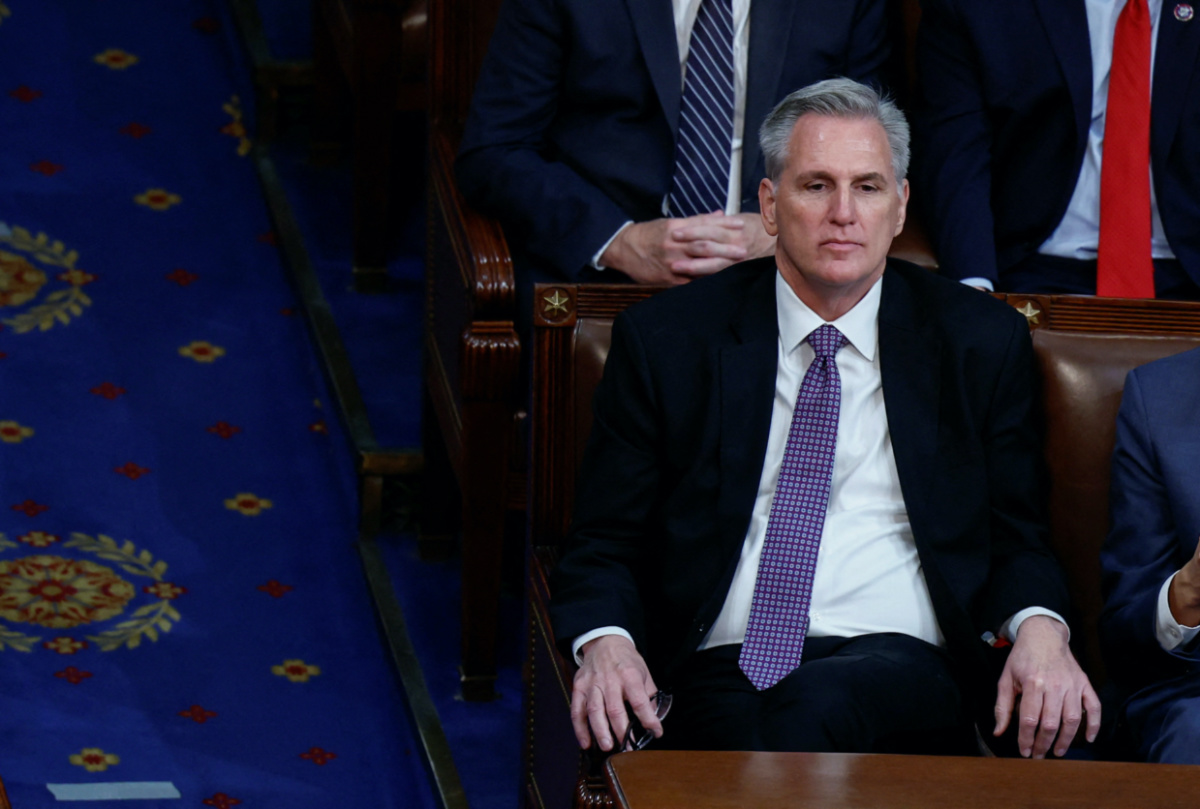
RICHARD HARGY, of Queen’s University Belfast, explains in an article first published on The Conversation…
For the first time in 100 years, the House of Representatives failed to elect a speaker after a first round vote and was forced to adjourn after three failed attempts. Fourth, fifth and sixth ballots were lost the following day.
Republican leader in the House Kevin McCarthy led his party to a narrow victory in November’s midterms with 222 seats to the Democrats’ 213. This was supposed to be the Republicans’ opportunity to showcase their legislative power in the lower house of Congress. Instead, what ensued was farce and chaos.

US House Republican Leader Kevin McCarthy (a Republican from California) watches and listens as a fourth round of voting for a new Speaker of the House fails to elect him Speaker on the second day of the 118th Congress at the US Capitol in Washington, US, on 4th January, 2023. PICTURE: Reuters/Evelyn Hockstein
After three ballots McCarthy failed to secure the backing of a majority of House members, needing 218 votes to become speaker. In the first two ballots he managed 203, with 19 members of his own party voting against him. This grew to 20 in the third ballot. These breakaway Republicans proposed and voted for their own preferred candidate – Congressman Jim Jordan of Ohio.
Jordan, a prominent hard-right Trump supporter, had nominated McCarthy prior to the second ballot. Jordan insisted there was “no chance” he would become speaker himself.
“Opposition to McCarthy from within Republican ranks is being orchestrated by members of the ‘Freedom Caucus’ – a group of ultra-conservative House members. McCarthy had made significant concessions to this faction, including agreeing to procedural reforms that would decentralise decision-making power and make it permissible to force a vote on motions to ‘vacate the chair’ – in effect, to remove the sitting speaker.”
Opposition to McCarthy from within Republican ranks is being orchestrated by members of the “Freedom Caucus” – a group of ultra-conservative House members. McCarthy had made significant concessions to this faction, including agreeing to procedural reforms that would decentralise decision-making power and make it permissible to force a vote on motions to “vacate the chair” – in effect, to remove the sitting speaker.
Challenges to power
Why is this important? The House of Representatives cannot convene without a speaker, the only leadership position mentioned in the US Constitution. Meanwhile, the business of government has been left in a state of paralysis. House committees cannot be formalised, and members of Congress are not technically members as they cannot be formally sworn in until all of this is over.
Whether or not McCarthy manages to win over some of the Republican rebels with more concessions, this debacle will have weakened his power base and ability to bring the party together. University of Chicago political scientist Ruth Bloch Rubin stated that McCarthy is “essentially hostage to one side of his party”.
Democrats could barely conceal their glee as they watched events unfold. Their House members remained solidly behind the Democrat leader in the chamber, Representative Hakeem Jeffries of New York. Strategists for President Joe Biden’s likely 2024 re-election campaign will seize on the anarchy within the Republican party to build a campaign message of stability and responsibility, as opposed to the opposite under Republicans.
Republican failure to elect a speaker also places the influence of former President Donald Trump in the national spotlight again. The Trump/McCarthy relationship endured a brief split following the attack on the US Capitol on 6th January, 2021. McCarthy initially blamed the former President for inciting the insurrection but made a quick volte-face, positioning himself since as a staunch defender of Trump.
Trump publicly endorsed McCarthy for the speakership last month. Asked on 3rd January, however, if he still supported him, the former President responded: “We’ll see what happens“. This equivocation only served to embolden Republican rebels, who are also loyal to Trump, to maintain their opposition to a McCarthy speakership.
Ahead of the fourth ballot, Trump took to his social media platform (Truth Social) to call for House Republicans to vote for McCarthy. Trump, now struggling to exercise the control over his party that he once had, is tying his own political relevance to McCarthy’s fate.
We rely on our readers to fund Sight's work - become a financial supporter today!
For more information, head to our Subscriber's page.
How long can the election go on?
The House of Representatives’ members will keep going until they get a decision. The longest set of ballots needed to settle the speakership occurred in 1856, when Nathaniel Prentice Banks won on a plurality of members rather than an absolute majority, after 133 votes.
In theory, this latest vote for speaker could run for days or even weeks. One unlikely scenario to resolve the impasse is to follow the example from 1856, and allow lawmakers to pass a resolution that would permit a speaker to again be elected by a plurality vote instead of a simple majority. But this would be incredibly risky for the Republican House leadership, as a split Republican vote could result in Democrat leader Hakeem Jeffries being handed the speaker’s gavel.
The House Republican party is now in turmoil and McCarthy says he will not be standing aside. The ultra-conservatives are a determined caucus, seemingly unfazed by the negative optics of incapacitating the legislative branch of government. What follows next and the gaping divisions caused by Republican fissures could make their House majority unworkable.![]()
Richard Hargy is a senior teacher and PhD candidate at Queen’s University Belfast. This article is republished from The Conversation under a Creative Commons license. Read the original article.






